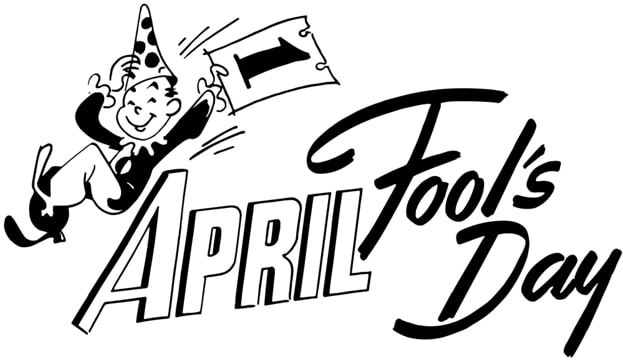By Marc McDermott
Introduction: Marc McDermott is a genealogist and blogger at GenealogyExplained.com. In this guest blog post, Marc shares some of the most memorable April Fool’s Day pranks from historical newspapers.
There’s still debate about how April Fool’s Day began. Some argue that its roots lay in the ancient Roman festival of Hilaria. Others say it was with the crowning of a Byzantine jester as “King for a Day.” However, there is no evidence for any of these stories. The historical references to April Fool’s Day begin in the Middle Ages. Some believe the concept was born from confusion over the celebration of the New Year when France switched from the Julian to Gregorian calendar in the late 16th century.

Kansas 1898
The confusion that April Fool’s Day can bring hasn’t stopped, and newspapers worldwide still join in the fun. The first pranks began appearing in newspapers in the 19th century. In 1898, the Iola Kansas Register claimed to have the tomahawk of the fearsome Native American leader “Loof Lirpa.” The name was April Fool, spelled backward. The successful prank took a month to dispel.
Germany 1905
In a more serious twist, the 1905 April Fool’s prank pulled by the German newspaper Berliner Tageblatt became international news. An article entitled “Der Millianardenraub im Bundes Schatzamt” was falsely attributed to a reporter in New York. The paper reported that the United States Treasury had been drained. The article claimed that well-funded American thieves had tunneled under the Treasury Building and, using a submarine and coding technology, made off with $269,000,000. In the currency of 2019, this is equivalent to approximately $8 billion.
The author of the piece was identified as a former member of the German Parliament. The article caused immense dismay around the world.
Denmark 1965
In Copenhagen, the newspaper Politiken reported chaos in the Danish Parliament as a measure was passed decreeing that all dogs be painted white. They stated that the law was passed in response to the low visibility of dogs during the night. The article touted the law as an improvement to safety on Danish roads. The joke was debunked only after readers began calling the paper to verify its truthfulness.
Famous Fools of the 1990s
One of the most famous newspaper pranks occurred in 1996. The fast-food chain Taco Bell took out a full-page ad in eight major newspapers. The Washington Post was one of the pranked papers. Claiming to have purchased the Liberty Bell, the restaurant company stated they made a move to control the national debt (which had grown to over $5 trillion by September of that year, about $8 trillion today). The ad claimed the symbol of American democracy would now be known as the “Taco Liberty Bell.” Although the prank was debunked by noon on April Fool’s Day, it left a bad taste in the mouths of many Americans.
In 1998, a second fast-food chain tried its hand at a newspaper prank. Burger King published a full-page ad in USA Today. Lampooning traditional attitudes about right-hand dominance versus left, Burger King invented the “left-handed Whopper.” The ad suggested that the left-handed Whopper would bring equality among all Burger King patrons. To customers’ disappointment, it was debunked after people appeared in stores and ordered the mythical sandwich.
The same year the left-handed Whopper reigned supreme, the National Fluid Milk Production Board claimed to have discovered a previously unknown Andy Warhol painting. The prank described the work as featuring Marilyn Monroe with a milk mustache. When readers called the 900 number at the bottom of the article, they were sent a calendar of celebrity milk mustaches for taking part in the joke.
April Fool’s Pranks Offer Glimpse into the Past
April Fool’s pranks have become a mainstay of the newspaper industry. They are an invitation not just to have a little fun but also to use caution and be careful readers. For the genealogist, they can be an intriguing look into the concerns of a historical period, ranging from fiscal responsibility to good governance and international relations.
Happy April Fool’s Day, everyone!
Explore over 330 years of newspapers and historical records in GenealogyBank. Discover your family story! Start a 7-Day Free Trial
Note on the header image: April Fool’s Day joke: an 1857 ticket to “Washing the Lions” at the Tower of London in London. No such event ever took place. Credit: Wikimedia Commons.
